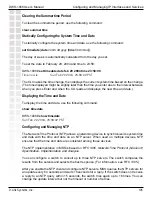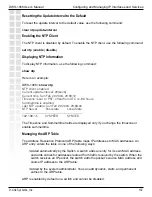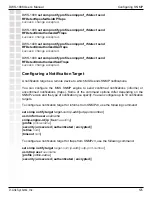
118
DWS-1008 User’s Manual
D-Link Systems, Inc.
Configuring SNMP
Creating a USM User for SNMPv3
To create a USM user for SNMPv3, use the following command:
set snmp usm
usm-username
snmp
-
engine
-
id
{
ip
ip-addr
|
local
|
hex
hex-string
}
access
{
read-only
|
read-notify
|
notify-only
|
read-write
|
notify-read-write
}
auth-type
{
none
|
md5
|
sha
} {
auth-pass-phrase
string
|
auth-key
hex-string
}
encrypt-type
{
none
|
des
|
3des
|
aes
} {
encrypt-pass-phrase
string
|
encrypt-key
hex-string
}
To clear a USM user, use the following command:
clear snmp usm
usm-username
The
usm-username
can be up to 32 alphanumeric characters long, with no spaces.
You can configure up to 10 SNMPv3 users.
The
snmp-engine-id
option specifies a unique identifier for an instance of an SNMP engine.
To send informs, you must specify the engine ID of the inform receiver. To send traps and to
allow get and set operations and so on, specify
local
as the engine ID.
•
hex
hex-string
- ID is a hexadecimal string.
•
ip
ip-addr
- ID is based on the IP address of the station running the management
application. Enter the IP address of the station. MSS calculates the engine ID based
on the address.
•
local
- Uses the value computed from the switch’s system IP address.
The
access
option specifies the access level of the user. The options are the same as the
access options for community strings.
















































